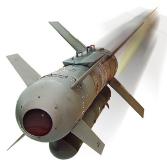|

An X-10 is shown at Edwards AFB, Cal. The X-10, used
to evaluate the guidance systems and flight characteristics of the
Navaho missile, was the first turbojet vehicle to reach a speed of Mach
2.

The Navaho G-26 (SM-64) pioneered
the piggyback launch configuration later used by the space shuttle.
|
As World War II came to a close in Europe, Germany introduced a deadly
new weapon: the V-2 ballistic missile. There was no defense against the
rocket-powered supersonic missile. As a result, destroying its launch
sites and capturing advanced rocket technology, as well as the German
scientists who created it, became a priority as the allies advanced
across Europe.
Similar research on rocketry and guided missile technology had been
largely neglected in the United States during the war. But after seeing
the V-2, it became a priority. The U.S. Army initiated a series of
postwar guided missile and rocket development programs with a number of
U.S. aviation companies.
One such program was
North American Aviation's Navaho, which began with a 1946 Army Air Force
contract that called for initial studies of existing rocket technology,
including technology collected from Germany, to develop a
surface-to-surface guided missile.
Other than captured
German rocket technology, none of the other technologies that were
needed to make Navaho existed. Everything from ramjet engines to
computer guidance, high-temperature materials and knowledge of the
aerodynamics of high-speed flight had to be developed from scratch. A
company report on Navaho stated: "North American found itself in the
position of a composer who is commissioned to write a symphony but must
base it on a new tonal scale, a new principle of harmonics and a new set
of instruments."
For the next four years, North American and the Air Force studied
various concepts. In 1950, they arrived at a phased program that was to
lead to a nuclear-armed, supersonic intercontinental-range
surface-to-surface missile designated the SM-64A Navaho.
The first phase was
an evaluation of the guidance systems and flight characteristics of the
Navaho missile. To evaluate them, North American built the
turbojet-powered X-10 test vehicle. The design of the X-10, with its
rear wings, long slender fuselage and canard control surfaces, later
influenced the design of the XB-70 Valkyrie, as well as the Boeing Sonic
Cruiser. The X-10 was the first turbojet-powered vehicle to reach Mach 2
(twice the speed of sound); it also was the first aircraft to fly a
complete mission under inertial (computerized) guidance and the first to
use a self-contained automatic landing system.
The next phase of
the Navaho program was the development of the SM-64 ground-to-ground
missile, or what North American called the G-26. The G-26 required the
development of powerful rocket engines and an autonavigator unit that
was small and lightweight. To develop them, North American pioneered
precise lightweight electronics through the use of transistors and the
development of printed circuit boards.
The
67-foot-long (20.4-meter), ramjet powered missile rode piggyback on a
76-foot (24-meter) booster powered by a pair of 200,000-pound-thrust
(890-kilonewton) engines. This powerful combination helped the G-26
become the first jet vehicle to reach Mach 3 and an altitude of 77,000
feet (23,500 meters).
In
July 1957, after extensive testing at Cape Canaveral Auxiliary Air Force
Base, Fla., the Air Force decided to go forward with ballistic missiles
for land-based nuclear deterrence and canceled the Navaho program. While
many Navaho delays and teething problems were due to its complexity, the
simple reason for its cancellation was the fact that a ballistic missile
traveling near Mach 20 would reach its target in a fraction of the time
and was (at the time) impossible to intercept.
During its nearly 10 years of development and testing, the Navaho
program made key technological breakthroughs .in nearly every discipline
of engineering and electronics. The pioneering work in developing the
rocket engines led to the formation of North American's Rocketdyne
division, still a leader in the development and production of rocket
engines. The pioneering work in the development of digital computer
technology and modular electronic circuitry as well as inertial guidance
systems would lead to the formation of North American's Autonetics
Division - now the home of the Boeing site in Anaheim, Calif.- and the
development of navigation systems for airplanes, missiles and even the
system used on the USS Nautilus to navigate under the polar
icecap.
"Even though it was cancelled, Navaho made important contributions to
the nation’s aerospace industry,” said Sam F. Iacobellis, retired
Rockwell executive vice president and chief operating officer, who
worked on the Navaho program early in his career at North American
Aviation. “In many ways the Navaho booster was more powerful than the
Atlas or Titan rockets and helped Rocketdyne in its development of the
7.5 million-pound-thrust (33,400-kilonewton) Saturn V rocket engines.
The Navaho is another example of ‘the patient died, but the operation
was a success’.
That success thrust North American Aviation into a position of
technological leadership that led to the company being selected for the
XB-70, X15 and A3J Vigilante programs, as well as two of the most
important and prestigious programs in aerospace history: the Apollo
spacecraft and the space shuttle.
November 2006 BOEING FRONTIERS |







